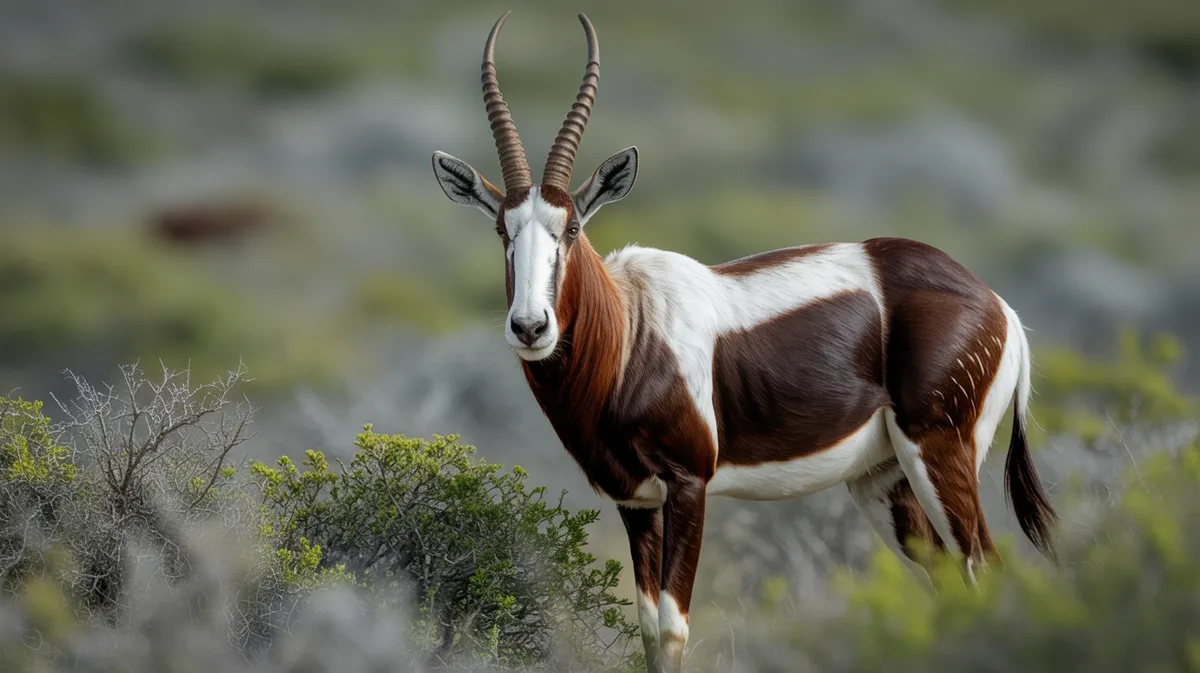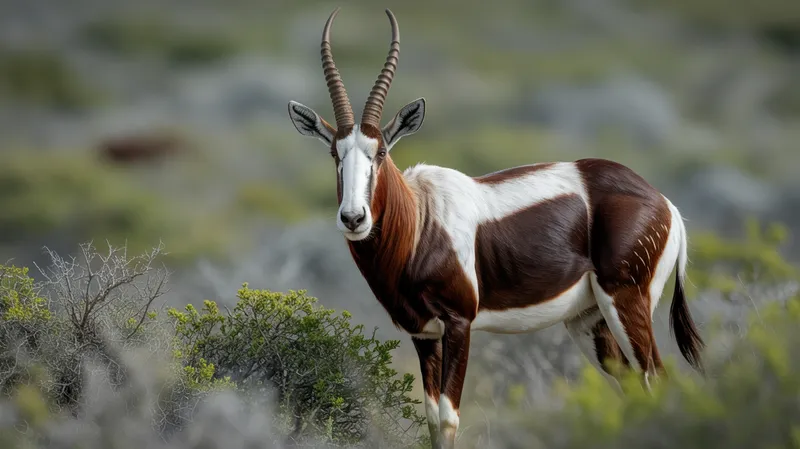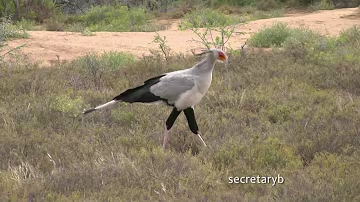
Bontebok
Damaliscus pygargus pygargus

Meet the Bontebok
The bontebok is a striking antelope native to the southern tip of South Africa, known for its sleek chocolate-brown coat with a distinctive white face and rump. Once on the brink of extinction due to hunting and habitat loss, the bontebok now mainly survives in protected reserves and conservation areas. They are social grazers, typically found in small herds, and are most active during the cooler parts of the day. Bonteboks prefer open grassland habitats where they feed primarily on short grasses.
Classification
Mammal
Habitat
Coastal Fynbos and grasslands
Diet
Herbivore
Lifespan
7-15 years
Conservation
Least Concern
Weight
50-80 kg
📖Fascinating Facts
Unique Coloration
Bonteboks have a rich brown coat with a prominent white blaze on their face and white rump, making them easy to identify.
Grassland Specialist
They are selective grazers, preferring short grasses in open habitats, and play a role in maintaining grassland health.
Conservation Success
Once nearly extinct, bonteboks have recovered due to dedicated conservation programs and now thrive in protected areas.
📋Detailed Description
The bontebok (Damaliscus pygargus pygargus) is a medium-sized antelope distinguished by its lustrous chocolate-brown to purplish coat, sharply contrasted by a prominent white blaze running from the forehead to the tip of the nose, and a conspicuous white rump patch above the tail. Adults typically stand 80–100 cm at the shoulder and weigh between 50–80 kg, with males slightly larger than females. Both sexes bear ringed, lyre-shaped horns that can reach 35–50 cm in length. The bontebok's legs are slender with distinctive white 'socks' on the lower limbs. Adapted for open grasslands and coastal fynbos, their vision and hearing are acute, aiding in predator detection. Bonteboks are diurnal, with peak activity in the early morning and late afternoon, and they rest in the shade during the heat of the day. Socially, they form small herds typically comprising females and their young, while adult males are territorial and maintain exclusive breeding territories. Bonteboks are selective grazers, favoring short grasses and forbs, and require regular access to water. Their population was once reduced to fewer than 20 individuals in the wild, but intensive conservation efforts have restored numbers to several thousand, though most now exist within fenced reserves.
💡 Did you know?
All wild bonteboks today descend from a single surviving population protected in South Africa's Bontebok National Park.
🔬Research & Sources
Wikipedia Summary
The bontebok is an antelope found in South Africa, Lesotho and Namibia. D. pygargus has two subspecies; the nominate subspecies, occurring naturally in the Fynbos and Renosterveld areas of the Western Cape, and the blesbok occurring in the Highveld.
Last Modified: 3/12/2025
🎭Behavior & Social Structure
Bonteboks are predominantly grazers, feeding on a variety of short grasses such as Themeda triandra and Cynodon dactylon, and occasionally forbs, especially during the wet season. They exhibit a strong preference for recently burned or grazed areas where new grass shoots are abundant. Social structure is based on small herds of 6–25 individuals, usually led by a dominant female. Males are territorial, marking boundaries with dung middens and scent from preorbital glands. Territorial disputes involve ritualized displays, including head-lowering, horn presentation, and parallel walking, rarely escalating to physical combat. Bonteboks are vigilant, relying on keen eyesight to detect predators such as leopards, caracals, and occasionally jackals. They communicate through a range of vocalizations, body postures, and scent marking. Daily routines include grazing during cooler periods, resting in shade at midday, and visiting water sources at least once daily.
👶Reproduction & Life Cycle
Bonteboks are seasonal breeders, with mating (rut) typically occurring from January to March, coinciding with the southern hemisphere's late summer. Males establish and defend territories to attract females. After a gestation period of approximately 238 days (about 7.5–8 months), females give birth to a single calf, usually between September and November, aligning with the spring flush of vegetation. Calves are precocial, able to stand and follow their mothers within an hour of birth. For the first few weeks, calves remain hidden in tall grass, with mothers visiting to nurse several times a day. Weaning occurs at about 4–6 months, and sexual maturity is reached at 2–2.5 years. Female bonteboks may breed annually under favorable conditions.
🛡️Adaptations & Survival
Bonteboks exhibit several adaptations to their open, sun-exposed habitats. Their dark, glossy coats reflect some solar radiation, while the white blaze and rump may play a role in social signaling and predator confusion. Their long, slender legs are built for endurance running, allowing them to escape predators in open terrain. Bonteboks are highly water-dependent compared to related antelopes, often restricting their range to areas with permanent water sources. Their selective grazing habits help them exploit nutrient-rich regrowth after fire or grazing. Behavioral adaptations include forming herds for increased vigilance and establishing dung middens for territory marking and parasite control.
📚Research Sources
🎨Cultural Significance
The bontebok holds symbolic value in South Africa as a conservation success story and is the namesake of Bontebok National Park, established in 1931 specifically to save the species from extinction. While the bontebok does not feature prominently in indigenous folklore, its striking appearance has made it a popular subject in South African art and ecotourism. Historically, its skins were valued for ceremonial uses, though such practices are now rare. The bontebok is also featured in regional emblems and conservation campaigns.
🔬Recent Research & Discoveries
Recent research has focused on the genetic health of bontebok populations, revealing concerns about low genetic diversity due to historical bottlenecks and ongoing hybridization with blesbok. Studies on grazing ecology have highlighted the bontebok's role in maintaining grassland biodiversity through selective feeding. Ongoing research includes satellite tracking to understand movement patterns in fragmented landscapes, and ecological studies on the impact of fire and invasive species on fynbos habitats. Conservation genetics projects are underway to develop management guidelines for maintaining genetic purity and adaptive potential.
🎥Wildlife Videos

Bontebok
"The Buck that could not jump" The Bontebok owes its survival to the fact that, unlike the springbuck, the impala and other ...
Wim Spronk

Bontebok#Emerald Resort
Bontebok.
Wild Nature

SOUTH AFRICA Bontebok national park (8 Feb 2025)
Bontebok National Park is a species-specific national park in South Africa. It was established in 1931 to ensure the preservation of ...
Harry Mateman

Bontebok facts 🦌 antelope found in South Africa 🇿🇦 Lesotho 🇱🇸 and Namibia 🇳🇦
amazinganimals facts for kids The bontebok is a subspecies of Damaliscus pygargus, an antelope found in South Africa, Lesotho ...
Amazing Planet!

SOUTH AFRICA birds at the restcamps of Karoo and Bontebok n.p. (hd-video)
Extended footage of birds we spotted at the restcamps of Karoo and Bontebok. Plus Blue Cranes and a Secretarybird at Mountain ...
Harry Mateman

Bontebok and Bongo antelope - The African Antelope
Bontebok and Bongo Antelope Video A video about the unusual, yet beautiful animal called bontebok and bongo antelope. This is ...
WILD WILD WORLD OF ANIMALS
🌍Habitat Information
The Bontebok typically inhabits Coastal Fynbos and grasslands environments. Bonteboks have adapted to their environments with specialized features and behaviors.
Primary Habitat:
Coastal Fynbos and grasslands
More detailed habitat information will be available soon.
🛡️Conservation Status
The Bontebok is currently classified as Least Concern. Conservation efforts are crucial for preserving this species for future generations.
Common Threats:
- 🏠Habitat loss and fragmentation
- 🌡️Climate change impacts
- 🎯Hunting and poaching
- 🏭Human-wildlife conflict
⚠️Threats & Conservation Challenges
Historically, bonteboks suffered catastrophic declines due to overhunting, habitat loss from agriculture, and competition with livestock, reaching a nadir of fewer than 20 individuals by the early 20th century. Today, while their numbers have rebounded to over 3,500 in the wild and several thousand in private reserves, they remain vulnerable due to limited genetic diversity, habitat fragmentation, and hybridization with the closely related blesbok (Damaliscus pygargus phillipsi) in some areas. Fencing and small reserve sizes can lead to overgrazing and inbreeding. Ongoing threats include disease transmission from livestock, poaching, and climate change impacts on their restricted fynbos habitat. Conservation management focuses on maintaining genetic integrity, habitat restoration, and population monitoring.
🔬Scientific Classification
Scientific Name
Damaliscus pygargus pygargus
Classification Hierarchy
🔍 About Taxonomic Classification
Taxonomic classification is a hierarchical system used by scientists to classify and organize living organisms based on shared characteristics and evolutionary relationships.
The system moves from broad categories (Kingdom) to increasingly specific ones, with each animal's scientific name typically consisting of its Genus and species.
📝Community Notes
Share your observations and insights about the Bontebok with our community of wildlife enthusiasts.
Join Our Community
Sign in to share your observations and connect with fellow wildlife enthusiasts.
Sign In to ContributeNo community notes yet
Be the first to share your observations about the Bontebok!
Explore Bontebok
Select a tab above to learn more about this amazing animal.
📸Photo Gallery
No photos available for this animal yet.
🌟Discover More Wildlife
Continue your journey of discovery with more fascinating animals from our database
